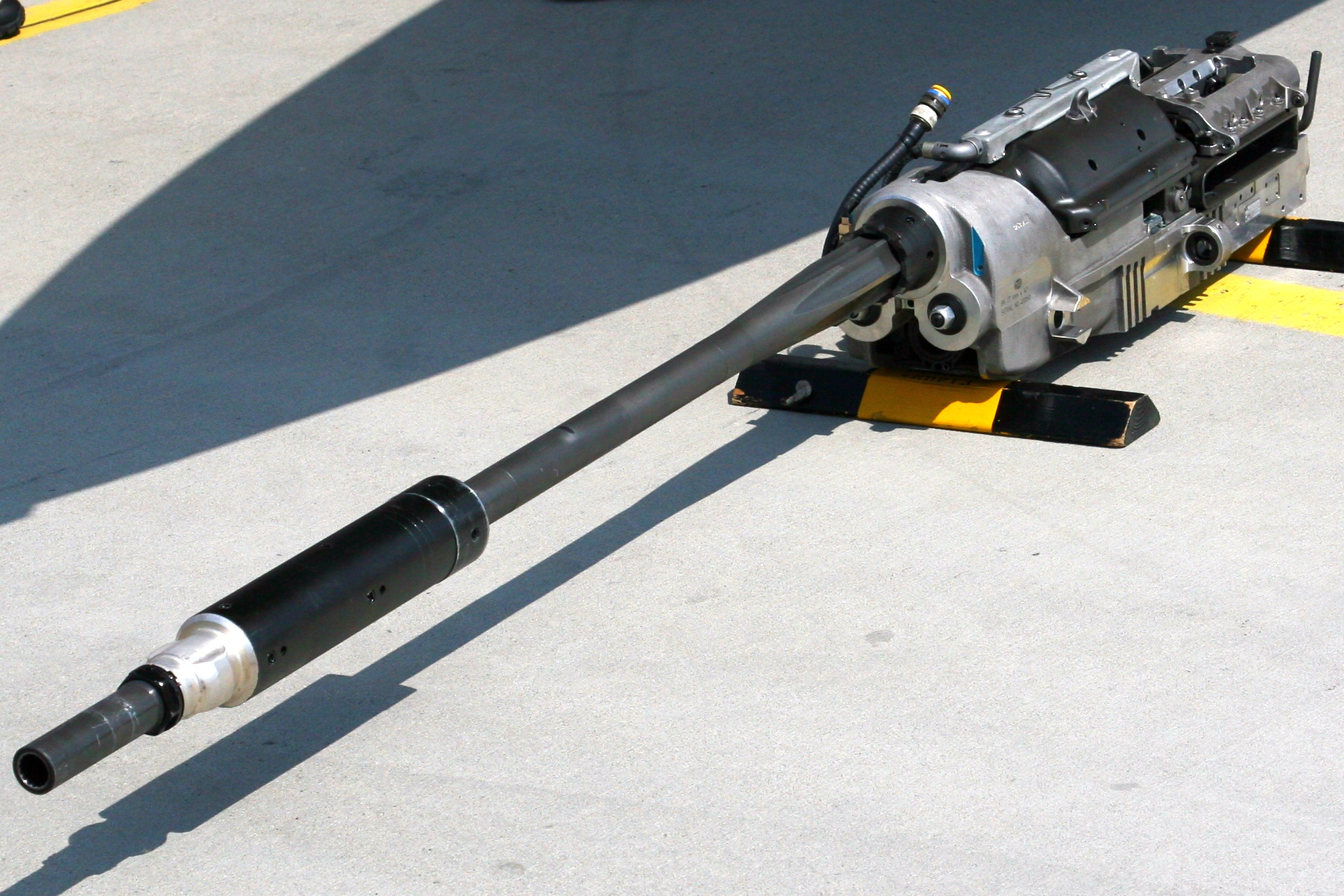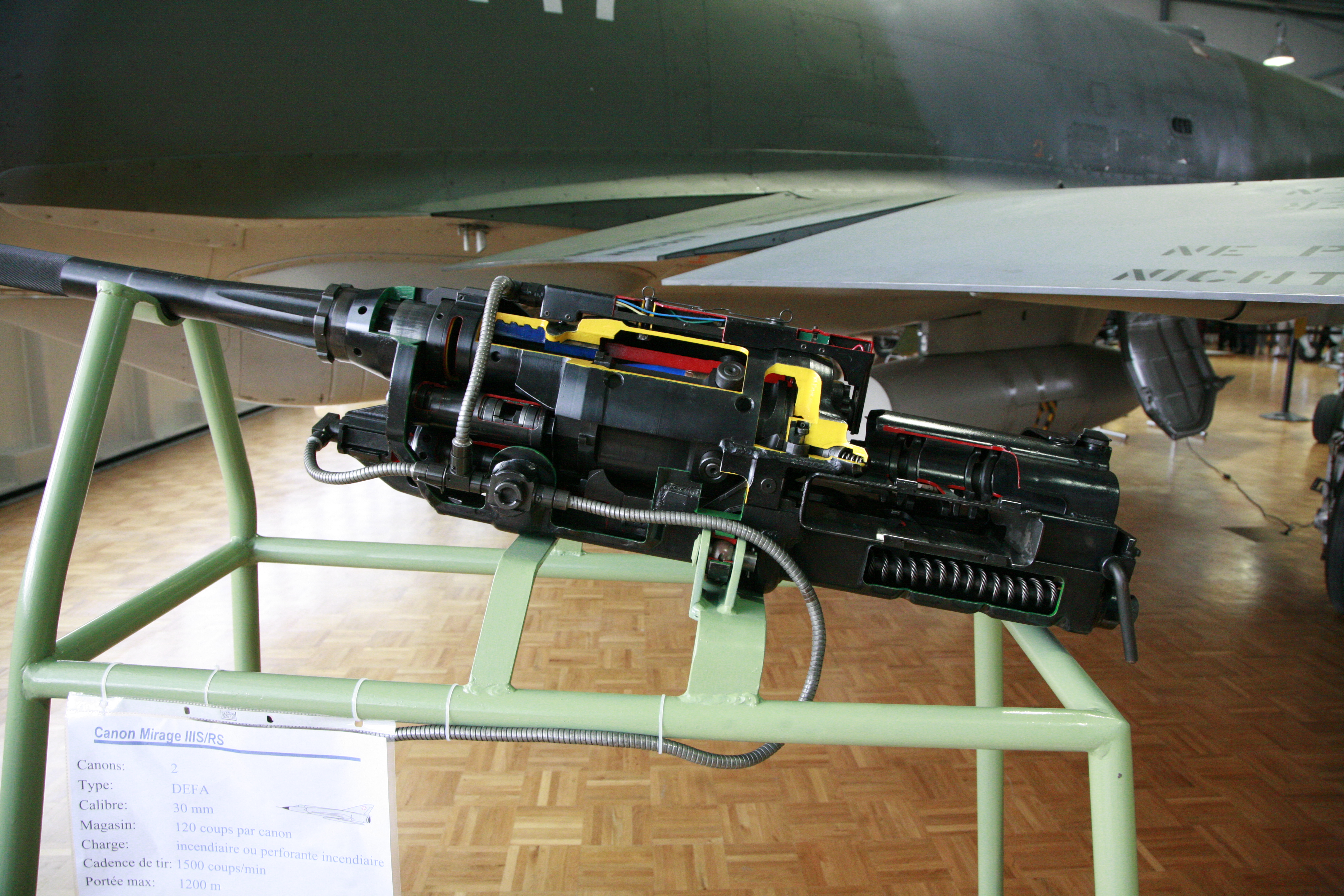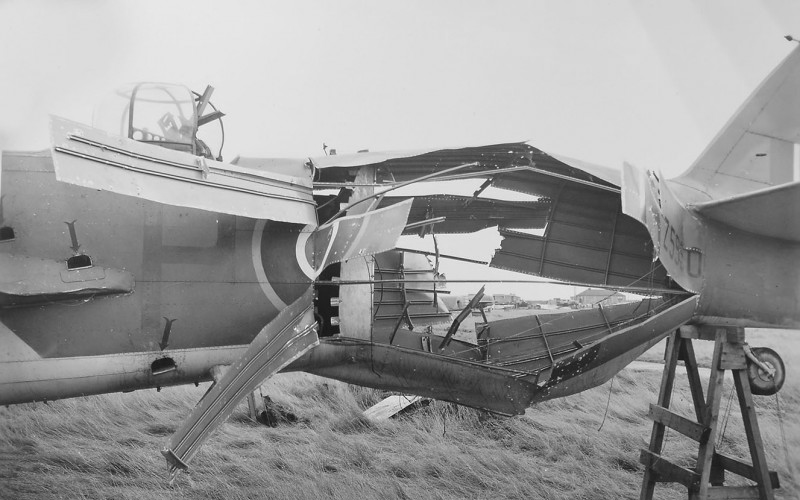|
Revolver Cannon
A revolver cannon is a type of autocannon, commonly used as an aircraft gun. It uses a cylinder with multiple chambers, like those of a revolver handgun, to speed up the loading-firing-ejection cycle. Some examples are also power-driven, to further speed the loading process. Unlike a rotary cannon, a revolver cannon only has a single barrel, so its spun weight is lower. Automatic revolver cannons have been produced by many different manufacturers. History Precursors An early precursor was the Puckle gun of 1718, a large flintlock revolver gun, manually operated. The design idea was impractical, far ahead of what 18th century technology could achieve. During the 19th century, Elisha Collier and later Samuel Colt used the revolver action to revolutionize handguns. The Confederate States of America used a single 2-inch, 5-shot revolver cannon with manually rotated chambers during the Siege of Petersburg. The gun was captured in Danville, Virginia by Union forces on April 2 ... [...More Info...] [...Related Items...] OR: [Wikipedia] [Google] [Baidu] |
Mauser BK-27 LKCV
Mauser, originally Königlich Württembergische Gewehrfabrik ("Royal Württemberg Rifle Factory"), was a German arms manufacturer. Their line of bolt-action rifles and semi-automatic pistols has been produced since the 1870s for the German armed forces. In the late 19th and early 20th centuries, Mauser designs were also exported and licensed to many countries which adopted them as military and civilian sporting firearms. The Gewehr 98 in particular was widely adopted and copied, and is the foundation of many of today's sporting bolt-action rifles. History King Frederick I founded the enterprise as Königliche Waffen Schmieden (literally: Royal Weapons Forges) on 31 July 1811. Originally located partly at Ludwigsburg and partly in Christophsthal, the factory transferred to the former Augustine Cloister in Oberndorf am Neckar, where Andreas Mauser worked as the master gunsmith. Of his seven sons who worked with him there, Peter Paul Mauser showed an outstanding ability to devel ... [...More Info...] [...Related Items...] OR: [Wikipedia] [Google] [Baidu] |
Hotchkiss Revolving Cannon
The Hotchkiss gun can refer to different products of the Hotchkiss arms company starting in the late 19th century. It usually refers to the 1.65-inch (42 mm) light mountain gun; there were also a navy (47 mm) and a 3-inch (76 mm) Hotchkiss guns. The 42 mm gun was intended to be mounted on a light carriage or packed on two mules to accompany a troop of cavalry or an army travelling in rough country. Descriptions 1.65-inch gun The gun and accessories could be packed on two mules. The gun was introduced as a modern replacement for the aging twelve-pounder mountain howitzer. The first gun purchased by the U.S. military from the French arms firm of Hotchkiss was employed against the Nez Percé in 1877. Over the next twenty years the U.S. purchased 56. They were used at the Wounded Knee Massacre in 1890, and again in Cuba at the Battle of Las Guasimas, the Battle of El Caney and the attack on San Juan Hill during the Spanish–American War of 1898. H ... [...More Info...] [...Related Items...] OR: [Wikipedia] [Google] [Baidu] |
Oerlikon KCA
The Oerlikon KCA is a Swiss gas-operated single-barrel revolver cannon developed for aircraft use. Its most noticeable use was on the JA 37 Viggen fighter mounted in a conformal pod as the ''akan m/75''. The KCA fires a shell that is 50% heavier than the NATO standard ammunition used on ADEN Aden ( ar, عدن ' Yemeni: ) is a city, and since 2015, the temporary capital of Yemen, near the eastern approach to the Red Sea (the Gulf of Aden), some east of the strait Bab-el-Mandeb. Its population is approximately 800,000 people. ... and DEFA cannon. It can fire up to 1350 rounds per minute at a muzzle velocity of 1030 m/s, with an effective range of References Oerlikon-Contraves 30 mm artillery Autocannon Aircraft guns {{weapon-stub ... [...More Info...] [...Related Items...] OR: [Wikipedia] [Google] [Baidu] |
DEFA Cannon
The DEFA cannon (''Direction des Études et Fabrications d'Armement'') is a family of widely-used French-made aircraft revolver cannon firing 30 mm caliber NATO standard rounds. Design history The initial DEFA 551 was developed in the late 1940s. It is based on the German Mauser MG 213C, an experimental revolver cannon developed for the ''Luftwaffe''. The MG 213 never reached production, but inspired the DEFA, the very similar British ADEN cannon, and the smaller American M39 cannon. As the ''DEFA 552'' it entered production in 1954. In 1968 an upgraded version, Canon 550-F3, was developed, entering production in 1971 as the ''DEFA 553''. The new version provided a new feed system, nitro-chrome plated steel barrel, forged drum casing, and improved electrical reliability. Overview The DEFA 553 is a gas-operated five-chamber revolver cannon using pyrotechnic cocking and electrical ignition. It fires a range of 30 mm ammunition of various types, and is capable of continuous fi ... [...More Info...] [...Related Items...] OR: [Wikipedia] [Google] [Baidu] |
ADEN Cannon
The Royal Small Arms Factory ADEN cannon (ADEN being an acronym for "Armament Development, Enfield") is a 30 mm revolver cannon used on many military aircraft, particularly those of the British Royal Air Force and Fleet Air Arm. Developed post-World War II primarily to meet British Air Ministry's requirement for increased lethality in aircraft armament, the cannon was fired electrically and is fully automatic once it is loaded. Design and development During World War II, the German firm Mauser began development of a radically new 20 mm autocannon using a motorised firing mechanism in order to improve the rate of fire. The weapon got the preliminary designation Mauser MG 213 and by the late-war period the design was beginning to mature. However the presence of large heavy bombers like the Boeing B-17 Flying Fortress and Avro Lancaster led to the need of up-arming ''Luftwaffe'' fighter aircraft with heavier cannons. Mauser responded to this by adapting the MaschinenGew ... [...More Info...] [...Related Items...] OR: [Wikipedia] [Google] [Baidu] |
Mauser MK 213
The Mauser MG 213 was a 20 mm aircraft-mounted revolver cannon developed for the ''Luftwaffe'' during World War II. It was never put into service, but the principles formed the basis for several post-war developments by the Allies. A 30 mm version was developed as the MG 213C or MK 213 and it was this that led to the British ADEN, French DEFA and American M39 cannon. Operation The gun was developed by Mauser but, as far as known, was never deployed. It was developed from an earlier design: the MG 213A. The MG 213A utilized a gas-driven operation. In the MG 213, the direct movement of the revolver cassette was changed to a diagonal cam with a follower. This actuated a rammer that both fed cartridges into the cylinders and revolved the cassette. Sealing was accomplished by packing the cylinder and breech with heat resistant steel. This innovation allowed chamber movement while the gas pressure was very high. The revolver cassette had five chambers and at least 3 chambers were ful ... [...More Info...] [...Related Items...] OR: [Wikipedia] [Google] [Baidu] |
Vyacheslav Ivanovich Silin
Vyacheslav Ivanovich Silin (1907—1975) was a leading weapons engineer in the Soviet Union. Biography Silin was born in Tula on February 22, 1907. In 1919, he began working at the Tula Arms Plant. His work was halted while he served in the Red Army from 1931-1932, but throughout the rest of his life, he was a leading figure in the engineering and construction of military technology for the Soviet Union. He was awarded the Order of Lenin in 1939 and the Lenin Prize in 1967. He died on November 20, 1975. Technology produced Silin produced several important weapons for the USSR, both through his engineering work and under his direction. Working at the Central Bureau for the Construction and Research of Recreational and Hunting Weapons in Tula, he was tasked with developing antitank grenade launchers and was directly involved in the creation of the main weapons for the BMP-1 and BMD - 2A28 gun. In 1935, his involvement with the project led to the development of the 7.62&nbs ... [...More Info...] [...Related Items...] OR: [Wikipedia] [Google] [Baidu] |
Forgotten Weapons
Forgotten Weapons is a website and channel appearing on YouTube, Utreon and Full30, created and presented by Ian McCollum, that covers the history of antique, obscure, and historically important firearms. Videos Forgotten Weapons frequently features unusual, rare, odd, experimental, or one-off firearms, such as the paratroop versions of the Empire of Japan's Arisaka Type 99 rifle featuring a folding stock attached to a cabinet hinge. McCollum covers the history of such firearms in detail, and often explains how important certain firearms were to the development of weapon technologies and the history of warfare. He also usually explains the functioning and parts of the gun by dissassembling it. McCollum often borrows the firearms from auction houses, most commonly the Rock Island Auction and Morphy Auctions. He has also written books and articles for ''Popular Mechanics'' on the topic of firearms. Platforms McCollum avoids political topics in favor of exclusively covering tech ... [...More Info...] [...Related Items...] OR: [Wikipedia] [Google] [Baidu] |
Gas-operated Reloading
Gas-operation is a system of operation used to provide energy to operate locked breech, autoloading firearms. In gas-operation, a portion of high-pressure gas from the cartridge being fired is used to power a mechanism to dispose of the spent case and insert a new cartridge into the chamber. Energy from the gas is harnessed through either a port in the barrel or a trap at the muzzle. This high-pressure gas impinges on a surface such as a piston head to provide motion for unlocking of the action, extraction of the spent case, ejection, cocking of the hammer or striker, chambering of a fresh cartridge, and locking of the action. History The first mention of using a gas piston in a single-shot breech-loading rifle comes from 1856, by the German Edward Lindner who patented his invention in the United States and Britain. In 1866, Englishman William Curtis filed the first patent on a gas-operated repeating rifle, but subsequently failed to develop that idea further. Between 18 ... [...More Info...] [...Related Items...] OR: [Wikipedia] [Google] [Baidu] |
ShKAS Machine Gun
The ShKAS (Shpitalny-Komaritski Aviatsionny Skorostrelny, Shpitalny-Komaritski rapid fire for aircraft; Russian: ШКАС - Шпитального-Комарицкого Авиационный Скорострельный) is a 7.62 mm calibre machine gun widely used by Soviet aircraft in the 1930s and during World War II. The ShKAS had the highest rate of fire of any aircraft machine gun in general service during WWII. It was designed by Boris Shpitalniy and Irinarkh Komaritsky and entered production in 1934. ShKAS was used in the majority of Soviet fighters and bombers and served as the basis for the ShVAK cannon. Description ShKAS is a gas-operated revolver-type machine gun; it has a single chamber in which the pin strikes the primer. A key element of the ShKAS' high rate of fire is the revolving drum (feed cage) that holds ten rounds and provides a very smooth, progressive removal of the cartridges from their disintegrating link belt. The bolt locking action is Browning ... [...More Info...] [...Related Items...] OR: [Wikipedia] [Google] [Baidu] |
M1895 Colt–Browning Machine Gun
The Colt–Browning M1895, nicknamed "potato digger" because of its unusual operating mechanism, is an air-cooled, belt-fed, gas-operated machine gun that fires from a closed bolt with a cyclic rate of 450 rounds per minute. Based on an 1889 design by John Browning and his brother Matthew S. Browning, it was the first successful gas-operated machine gun to enter service. Operating mechanism Filed for patent in 1892, the M1895's operating mechanism is one of John and Matthew S. Browning's early patents for automatic rifles; they had previously been working on lever-action rifles for Winchester such as the Winchester 1886. In a typical lever-action design, the operating lever lies under the rear of the gun, typically below the stock, and is hinged near the breech area. It is operated by rotating the lever down and forward, which causes the breechblock to slide rearward away from the barrel and eject the spent round. The potato digger mechanism, in effect, bears some similari ... [...More Info...] [...Related Items...] OR: [Wikipedia] [Google] [Baidu] |






